Exploring Mechanical Properties Using the Hydraulic Bulge Test and Uniaxial Tensile Test with Micro-Samples for Metals
Abstract
:1. Introduction
2. Materials and Methods
2.1. Materials
2.2. Hydraulic Bulge Test
2.3. Uniaxial Tensile Test
3. Results
3.1. Results of the HBT
3.2. Results of the UTT
3.3. Comparison of Mechanical Parameters between the HBT and UTT
3.4. Fracture Mechanisms of the HBT and UTT
4. Discussion
4.1. Correlation between the HBT and UTT
4.2. Calculation of Biaxial Stress
4.3. Calculation of Biaxial Strain
4.4. Relationship of the Stress–Strain Curves between the HBT and UTT
5. Conclusions
Author Contributions
Funding
Data Availability Statement
Conflicts of Interest
References
- Barsoum, I.; Lawal, S.A.; Simmons, R.J.; Rodrigues, C.C. Failure analysis of a pressure vessel subjected to an internal blast load. Eng. Fail. Anal. 2018, 91, 354–369. [Google Scholar] [CrossRef]
- Zheng, Y.; Yang, S.; Ling, X. Creep life prediction of small punch creep testing specimens for service-exposed Cr5Mo using the theta-projection method. Eng. Fail. Anal. 2017, 72, 58–66. [Google Scholar] [CrossRef]
- Zhang, T.; Shang, X.; Zhang, N.; Lu, K.; Xie, M. An investigation on fracture toughness predictions from mini-sized uniaxial tensile specimens with global and local approaches. Theor. Appl. Fract. Mech. 2024, 131, 104366. [Google Scholar] [CrossRef]
- Lai, H.S.; Wang, R.; Zhong, Y.; Du, P.; Guo, J.; Huang, Q. A modified small punch testing scheme to investigate the circumferential mechanical behavior of nuclear fuel cladding tubes. J. Nucl. Mater. 2023, 583, 154517. [Google Scholar] [CrossRef]
- Shi, J.; Guo, Z.-J.; Wang, J.-X.; Liu, X.; Zhou, Y.; Tang, J.-Q.; Wen, J.-F.; Tu, S.-T. A novel small specimen testing method based on a pneumatic bulging test: Measurement of tensile properties at high temperatures. Int. J. Press. Vessel. Pip. 2024, 209, 105210. [Google Scholar] [CrossRef]
- Jeffs, S.; Douglas, R.; Beard, W.; Coleman, M.; Adams, J.; Jones, T.; Poole, D.; Lancaster, R. Characterising the high temperature tensile behaviour of laser powder bed fused duplex stainless steel 2205 using the small punch test. Mater. Charact. 2022, 189, 111953. [Google Scholar]
- Peng, J.; Gao, M.; Zhang, H.; Geng, X.; Liu, X.; Pan, H. Small punch creep test reveals the differences of high-temperature creep behaviours for laser powder bed fusion and Rolled Inconel 718 alloys. Mater. Sci. Eng. A 2023, 886, 145698. [Google Scholar] [CrossRef]
- Wang, X.; Xu, L.; Zhao, L.; Han, Y. Evaluation of defect-related fatigue performance of additive manufacturing GH4169 via small punch test. Theor. Appl. Fract. Mech. 2023, 128, 104162. [Google Scholar] [CrossRef]
- Altstadt, E.; Bergner, F.; Houska, M. Use of the small punch test for the estimation of ductile-to-brittle transition temperature shift of irradiated steels. Nucl. Mater. Energy 2021, 26, 100918. [Google Scholar] [CrossRef]
- Zu, Y.; Cao, Y.; Zhen, Y.; Li, F.; Wu, G. Determination on the fracture toughness of the welded joints of X80 pipeline steels based on small punch test. Eng. Fract. Mech. 2023, 291, 109525. [Google Scholar] [CrossRef]
- Chen, K.; Scales, M.; Kyriakides, S.; Corona, E. Effects of anisotropy on material hardening and burst in the bulge test. Int. J. Solids Struct. 2016, 82, 70–84. [Google Scholar] [CrossRef]
- Kim, H.; Lee, J.; Barlat, F.; Kim, D.; Lee, M.-G. Experiment and modeling to investigate the effect of stress state, strain and temperature on martensitic phase transformation in TRIP-assisted steel. Acta Mater. 2015, 97, 435–444. [Google Scholar] [CrossRef]
- Boyer, A.; Demazel, N.; Coër, J.; Carin, M.; Laurent, H.; Oliveira, M.C. A novel hydraulic bulge test in hot forming conditions. J. Mater. Process. Technol. 2023, 316, 117917. [Google Scholar]
- Liu, K.; Lang, L.; Cai, G.; Yang, X.; Guo, C.; Liu, B. A novel approach to determine plastic hardening curves of AA7075 sheet utilizing hydraulic bulging test at elevated temperature. Int. J. Mech. Sci. 2015, 100, 328–338. [Google Scholar] [CrossRef]
- Nasser, A.; Yadav, A.; Pathak, P.; Altan, T. Determination of the flow stress of five AHSS sheet materials (DP 600, DP 780, DP 780-CR, DP 780-HY and TRIP 780) using the uniaxial tensile and the biaxial Viscous Pressure Bulge (VPB) tests. J. Mater. Process. Technol. 2010, 210, 429–436. [Google Scholar]
- Dzugan, J.; Lucon, E.; Koukolikova, M.; Li, Y.; Rzepa, S.; Yasin, M.S.; Shao, S.; Shamsaei, N.; Seifi, M.; Lodeiro, M.; et al. ASTM interlaboratory study on tensile testing of AM deposited and wrought steel using miniature specimens. Theor. Appl. Fract. Mech. 2024, 131, 104410. [Google Scholar]
- Jackson, K.M. Fracture strength, elastic modulus and Poisson’s ratio of polycrystalline 3C thin-film silicon carbide found by microsample tensile testing. Sens. Actuators A Phys. 2005, 125, 34–40. [Google Scholar]
- Jiao, Y.; Chen, Y.; Yang, H.; Wang, C. Experimental characterization on fracture behavior of UHPMC under small-scale sample tensile testing: Acoustic emission monitoring and digital image correlation. Theor. Appl. Fract. Mech. 2024, 130, 104342. [Google Scholar]
- Molak, R.M.; Paradowski, K.; Brynk, T.; Ciupinski, L.; Pakiela, Z.; Kurzydlowski, K.J. Measurement of mechanical properties in a 316L stainless steel welded joint. Int. J. Press. Vessel. Pip. 2009, 86, 43–47. [Google Scholar] [CrossRef]
- Qian, X.; Cao, Y.; Liu, Z.; Lu, J. Influence of hardening behaviour of elastoplastic materials on the determination of elastic modulus using indentation tests. Mater. Sci. Eng. A 2010, 527, 4571–4575. [Google Scholar]
- Hill, R.C. A theory of the plastic bulging of a metal diaphragm by lateral pressure. Lond. Edinb. Dublin Philos. Mag. J. Sci. 1950, 41, 1133–1142. [Google Scholar] [CrossRef]
- Gutscher, G.; Wu, H.-C.; Ngaile, G.; Altan, T. Determination of flow stress for sheet metal forming using the viscous pressure bulge (VPB) test. J. Mater. Process. Technol. 2004, 146, 1–7. [Google Scholar] [CrossRef]
- Chakrabarty, J.; Alexander, J.M. Hydrostatic bulging of circular diaphragms. J. Strain Anal. Eng. Des. 1970, 5, 155–161. [Google Scholar] [CrossRef]
- Kruglov, A.A.; Enikeev, F.U.; Lutfullin, R.Y. Superplastic forming of a spherical shell out a welded envelope. Mater. Sci. Eng. A 2002, 323, 416–426. [Google Scholar] [CrossRef]
- Koç, M.; Billur, E.; Cora, Ö.N. An experimental study on the comparative assessment of hydraulic bulge test analysis methods. Mater. Des. 2011, 32, 272–281. [Google Scholar] [CrossRef]
- Sigvant, M.; Mattiasson, K.; Vegter, H.; Thilderkvist, P. A viscous pressure bulge test for the determination of a plastic hardening curve and equibiaxial material data. Int. J. Mater. Form. 2009, 2, 235–242. [Google Scholar] [CrossRef]
- Atkinson, M. Accurate determination of biaxial stress-strain relationships from hydraulic bulging tests of sheet metals. Int. J. Mech. Sci. 1997, 39, 761–769. [Google Scholar] [CrossRef]
- Gonoring, T.B.; Moreira, L.P.; Orlando, M.T.D.A. An equivalent work-hardening description of an interstitial-free steel sheet based on uniaxial tensile and hydraulic bulge tests. J. Mater. Res. Technol. 2021, 13, 2138–2143. [Google Scholar] [CrossRef]
- Amaral, R.; Santosa, A.D.; Lopes, A.B. Mechanical properties determination of dual-phase steels using uniaxial tensile and hydraulic bulge test. Ciênc. Tecnol. Dos Mater. 2017, 29, e239–e243. [Google Scholar] [CrossRef]
- ISO 16808:2022; Metallic Materials—Sheet and Strip—Determination of Biaxial Stress-Strain Curve by Means of Bulge Test with Optical Measuring Systems. ISO: Geneva, Switzerland, 2022.
- BS EN ISO 6892-1; Metallic Materials-Tensile Testing-Part 1: Method of Test at Room Temperature. British Standards Institution: London, UK, 2019.
- GOM GmbH. (n.d.). GOM Correlate. Available online: https://www.gom.com (accessed on 1 October 2020).
- Moreno, M.F.; Bertolino, G.; Yawny, A. The significance of specimen displacement definition on the mechanical properties derived from Small Punch Test. Mater. Des. 2016, 95, 623–631. [Google Scholar] [CrossRef]
- Mirnia, M.J.; Vahdani, M. Calibration of ductile fracture criterion from shear to equibiaxial tension using hydraulic bulge test. J. Mater. Process. Technol. 2020, 280, 116589. [Google Scholar] [CrossRef]
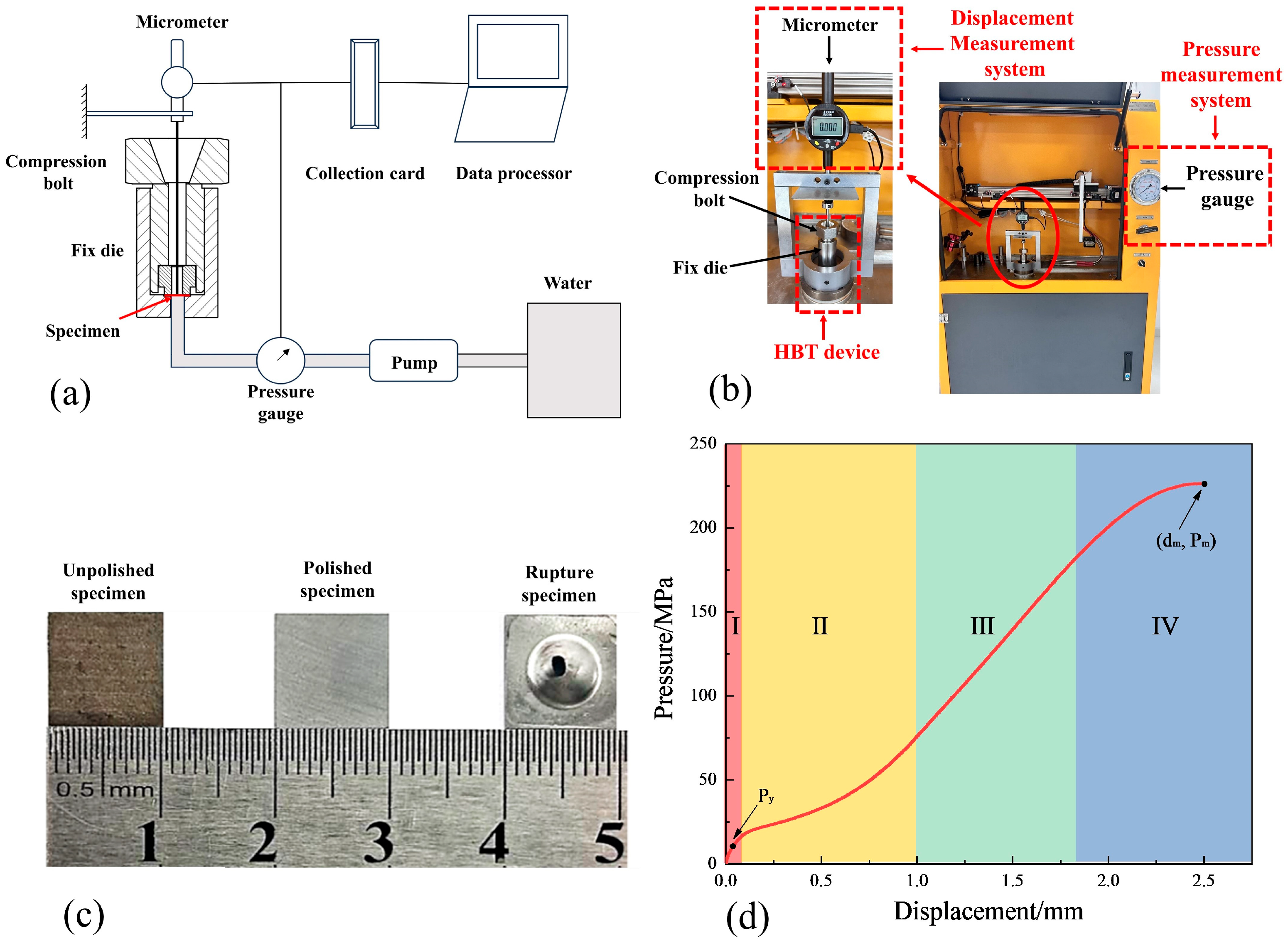
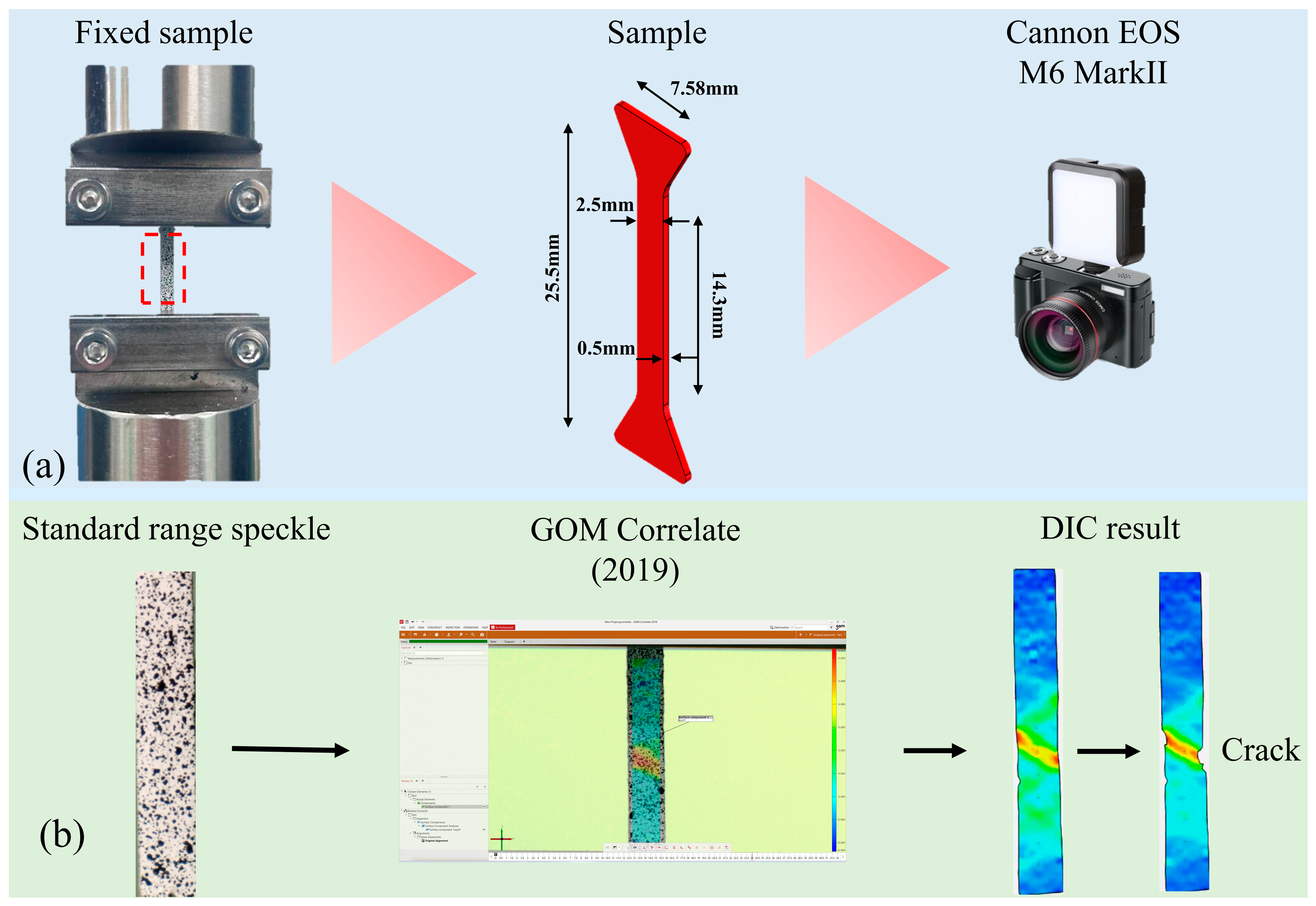
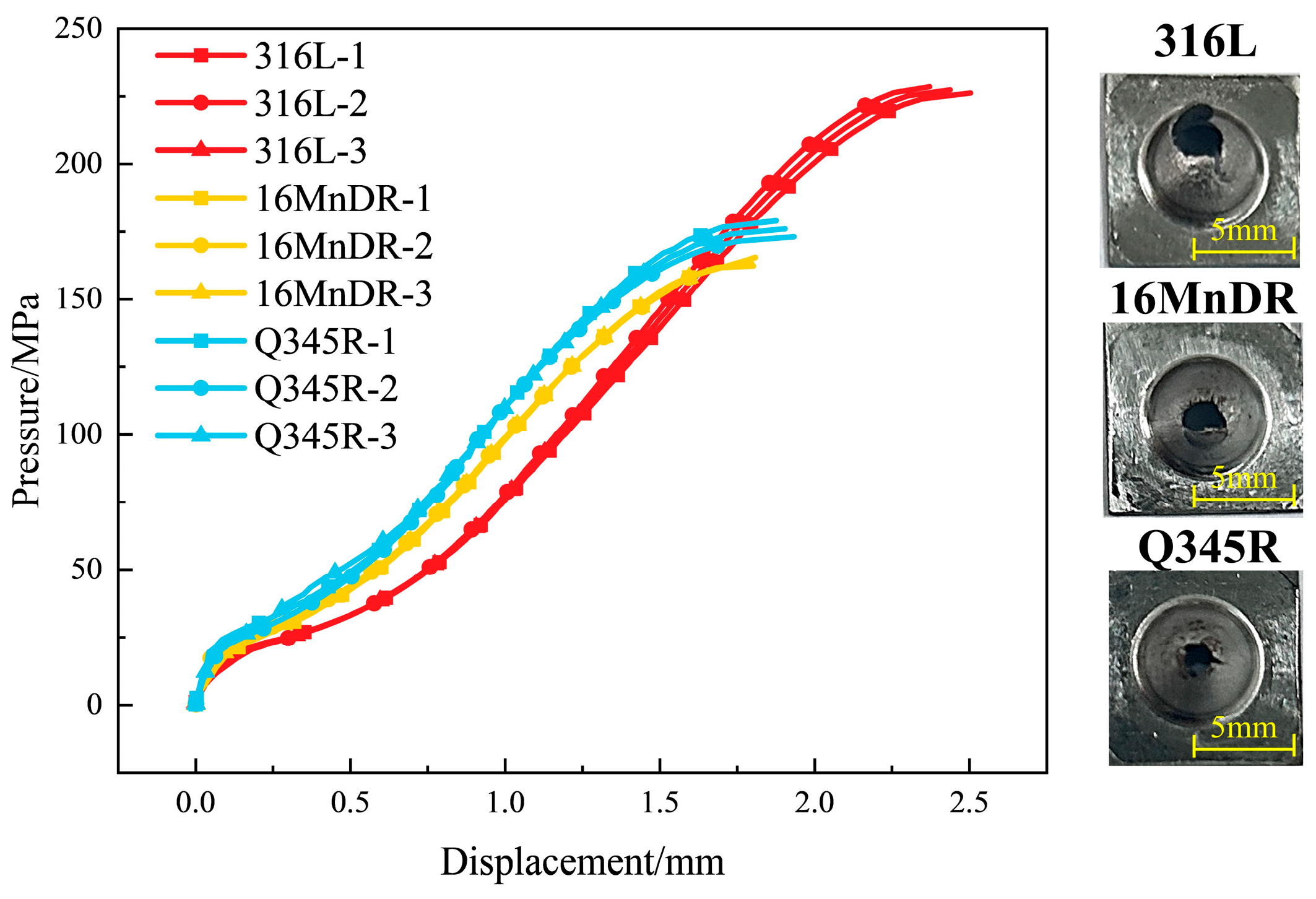


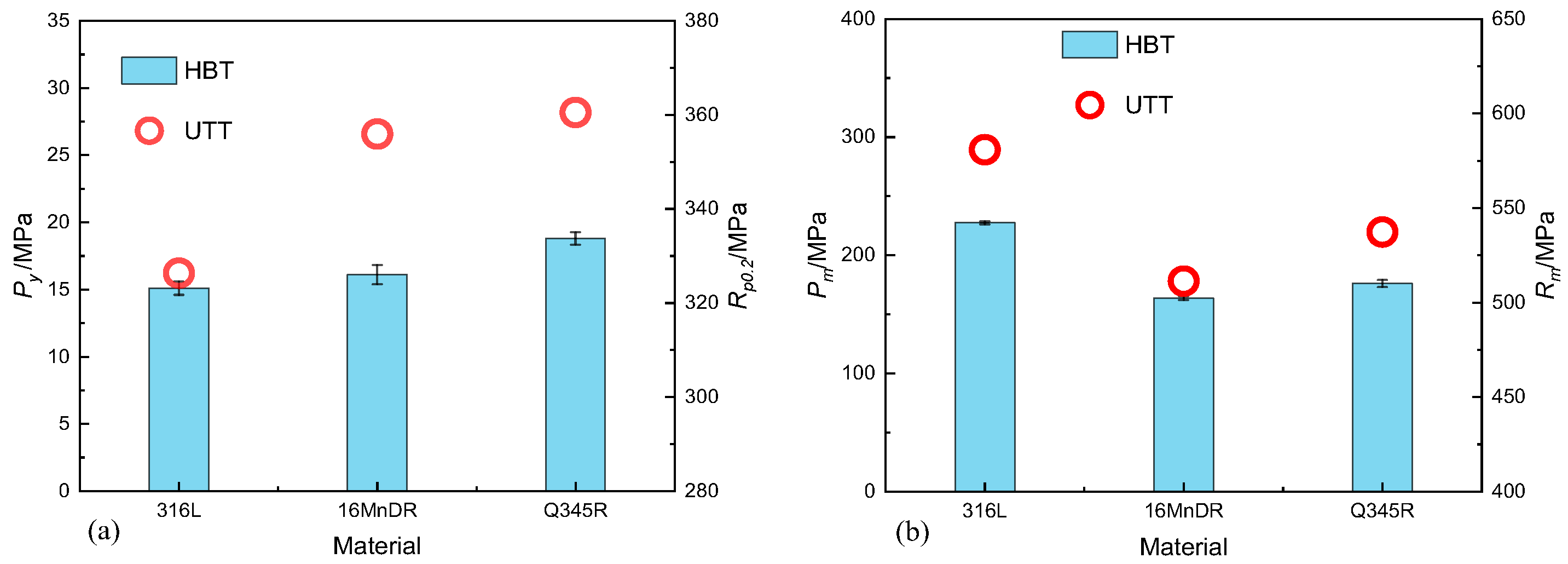
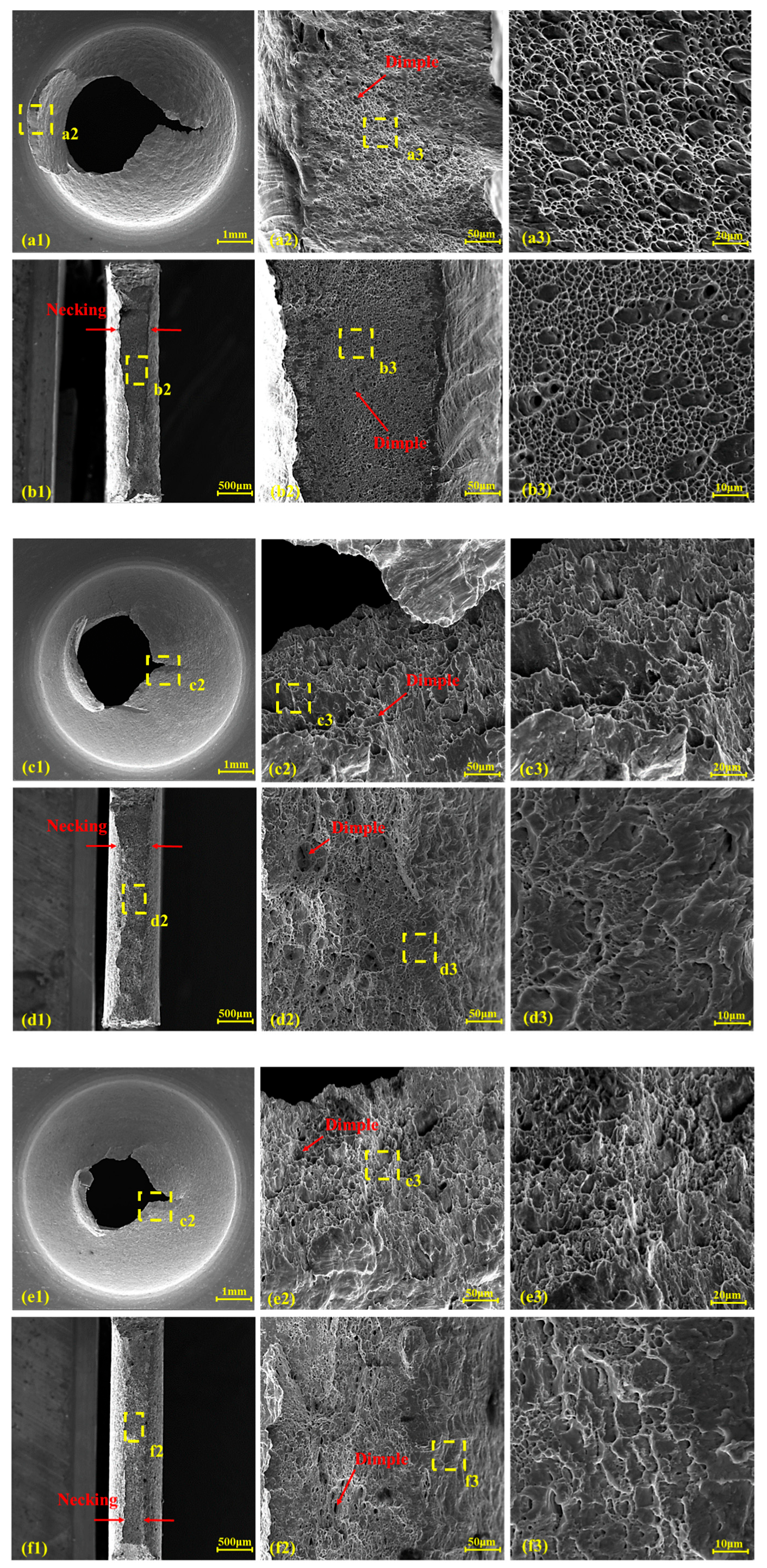
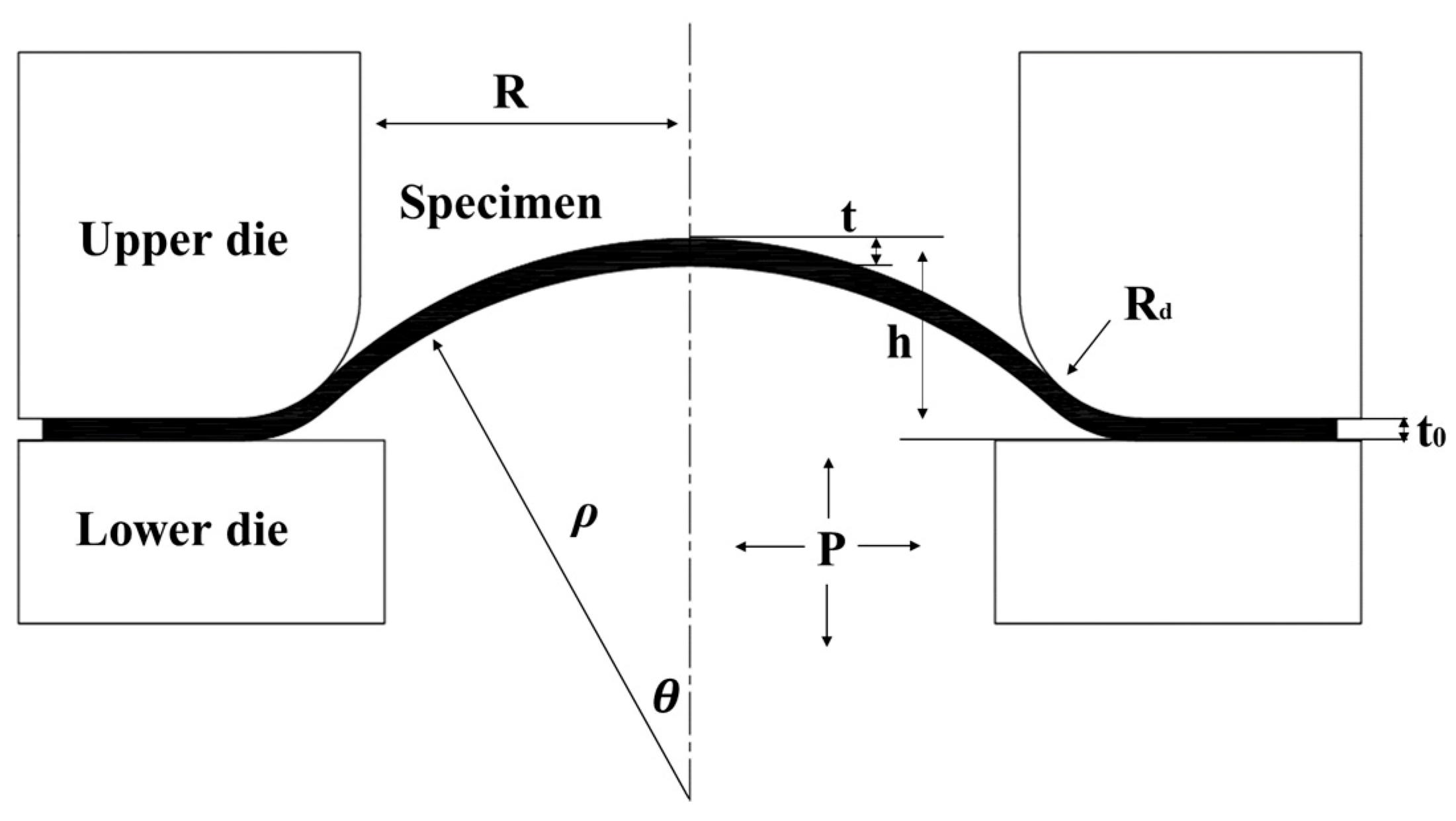


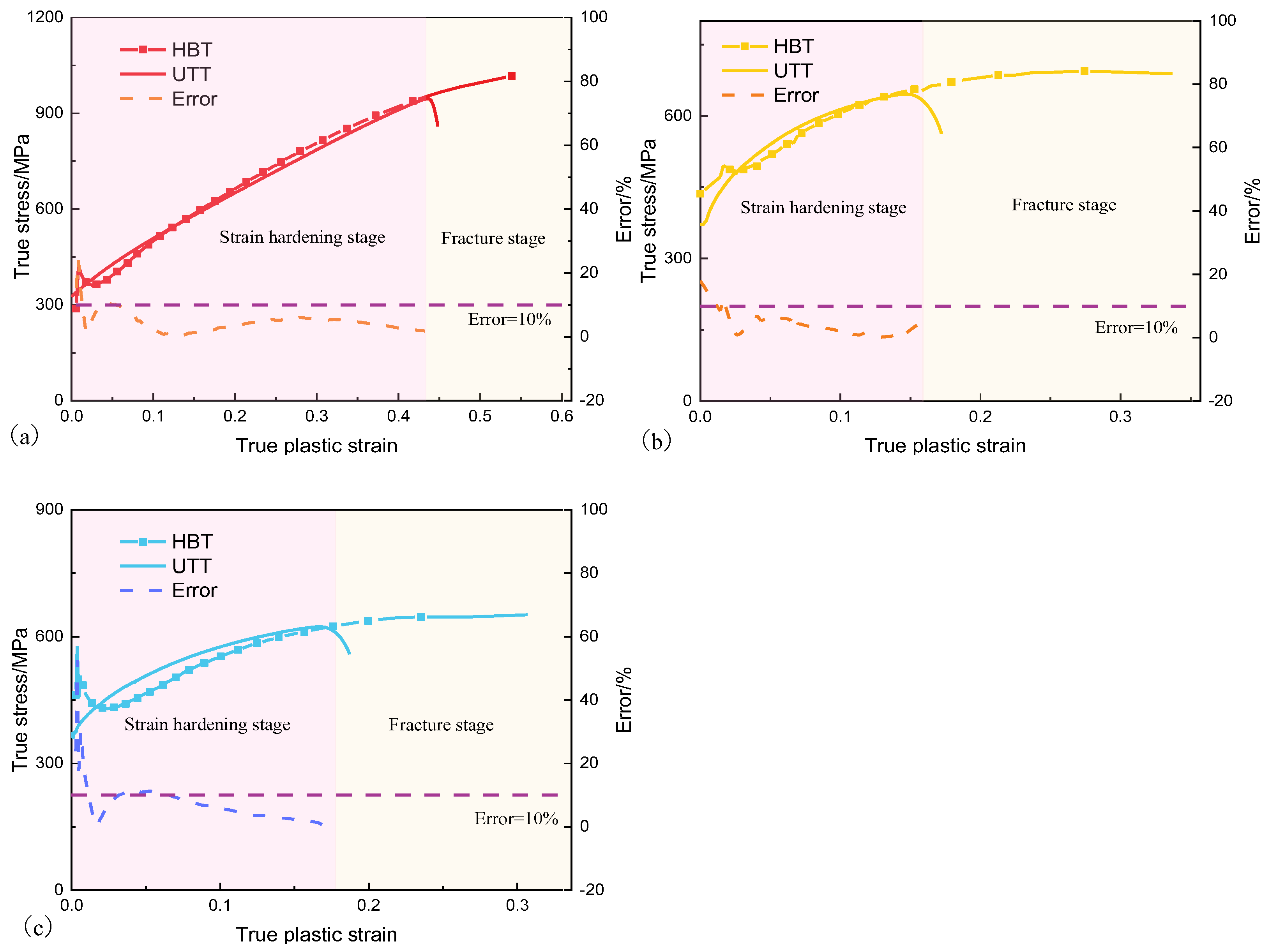
| Approach | Vertex Thickness |
|---|---|
| Hill [21] | |
| Chakrabarty-Alexander [23] | |
| Kruglov [24] |
| Element | C | Si | S | P | Cr | Ni | Mn | Mo | Al | Fe |
|---|---|---|---|---|---|---|---|---|---|---|
| 316L | 0.017 | 0.52 | 0.024 | 0.011 | 16.72 | 10.12 | 0.71 | 2.56 | - | Bal. |
| 16MnDR | 0.14 | 0.35 | 0.0012 | 0.013 | - | - | 1.47 | - | 0.045 | Bal. |
| Q345R | 0.18 | 0.24 | 0.007 | 0.015 | 0.03 | 0.01 | 1.27 | 0.005 | - | Bal. |
| Material | /MPa | /MPa | /mm |
|---|---|---|---|
| 316L-1 | 14.6 | 226.3 | 2.50 |
| 316L-2 | 15.1 | 228.6 | 2.37 |
| 316L-3 | 15.6 | 227.4 | 2.44 |
| 316L-Mean | 15.1 | 227.4 | 2.44 |
| 316L-Standard deviation | 0.50 | 1.15 | 0.06 |
| 16MnDR-1 | 16.3 | 165.5 | 1.81 |
| 16MnDR-2 | 15.3 | 163.3 | 1.79 |
| 16MnDR-3 | 16.7 | 162.4 | 1.80 |
| 16MnDR-Mean | 16.1 | 163.7 | 1.80 |
| 16MnDR-Standard deviation | 0.72 | 1.59 | 0.01 |
| Q345R-1 | 19.3 | 179.1 | 1.88 |
| Q345R-2 | 18.4 | 173.1 | 1.83 |
| Q345R-3 | 18.7 | 176.1 | 1.90 |
| Q345R-Mean | 18.8 | 176.1 | 1.87 |
| Q345R-Standard deviation | 0.46 | 3.01 | 0.04 |
| Material | Rp0.2/MPa | Rm/MPa |
|---|---|---|
| 316L | 326.34 | 580.87 |
| 16MnDR | 355.92 | 511.34 |
| Q345R | 360.52 | 537.28 |
| Material | 316L | 16MnDR | Q345R |
|---|---|---|---|
| k | 0.9141 | 0.8157 | 0.8284 |
Disclaimer/Publisher’s Note: The statements, opinions and data contained in all publications are solely those of the individual author(s) and contributor(s) and not of MDPI and/or the editor(s). MDPI and/or the editor(s) disclaim responsibility for any injury to people or property resulting from any ideas, methods, instructions or products referred to in the content. |
© 2024 by the authors. Licensee MDPI, Basel, Switzerland. This article is an open access article distributed under the terms and conditions of the Creative Commons Attribution (CC BY) license (https://creativecommons.org/licenses/by/4.0/).
Share and Cite
Bao, J.; Ding, H.; Zuo, Z.; Peng, J. Exploring Mechanical Properties Using the Hydraulic Bulge Test and Uniaxial Tensile Test with Micro-Samples for Metals. Metals 2024, 14, 917. https://doi.org/10.3390/met14080917
Bao J, Ding H, Zuo Z, Peng J. Exploring Mechanical Properties Using the Hydraulic Bulge Test and Uniaxial Tensile Test with Micro-Samples for Metals. Metals. 2024; 14(8):917. https://doi.org/10.3390/met14080917
Chicago/Turabian StyleBao, Jian, Haoran Ding, Zhiquan Zuo, and Jian Peng. 2024. "Exploring Mechanical Properties Using the Hydraulic Bulge Test and Uniaxial Tensile Test with Micro-Samples for Metals" Metals 14, no. 8: 917. https://doi.org/10.3390/met14080917






